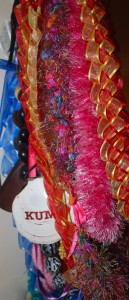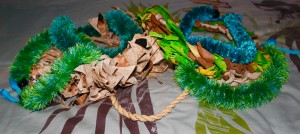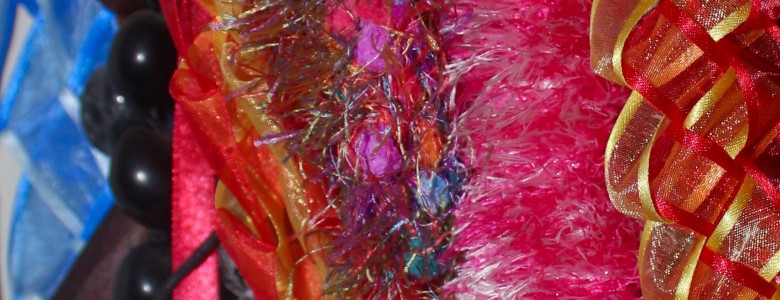E lei no au i ko aloha 
I will wear your love as a wreath
I will cherish your love as a beautiful adornment
A lei is a common symbol of love, friendship, celebration, honour or greeting. In other words, it is a symbol of Aloha.
Lei can be worn, received, or given for almost any occasion. In Hawaii, a lei is given for greeting, farewell, a symbol of affection, an office promotion, a birthday, an anniversary, a graduation or any special event. There’s never a wrong occasion to wear a lei. You never need to wait for a special occasion.
A lei can be worn for no other reason than to enjoy or simply, to celebrate the “Aloha Spirit.”
It has become the quintessential symbol of an Hawaiian greeting. However,there are many deeper cultural and spiritual aspects and elements in the protocol of this cherished Hawaiian custom, that are often overlooked or not understood in modern times or by visitors to the Islands.
In ancient Hawai‘i, respect and honor was bestowed upon someone by placing a lei upon their head or shoulders. They were also bestowed to illustrate the connection between the mundane and the sacred.
The giving of a lei is a significant gesture, as weaved into it is the mana and trust of the person who made it and the person who offered it. It creates or symbolizes a relationship between giver and receiver.
A lei may be made from many objects. Traditionally flowers, leaves, feathers, nuts or shells and of more modern times ribbon, beads, paper, silk or wool.
Protocol of Presenting a Lei
The whole idea of presenting a lei is to show honour, respect, to show high regard, love.
Traditionally, when presenting a lei Hawaiians embrace each other, touch noses and honi – traditional sacred and honoring  aspect of greeting of Native Hawaiian spirituality and culture. Exchanging the HA breath, the pure breath. Greeting and acknowledging the Spirit and the Life. ‘I recognise you as Life Spirit’
aspect of greeting of Native Hawaiian spirituality and culture. Exchanging the HA breath, the pure breath. Greeting and acknowledging the Spirit and the Life. ‘I recognise you as Life Spirit’
As said by Barbara Meheula, revered lei maker on the Big Island ”The kissing is very touristy.” ”The most precious thing to a Hawaiian is breath, the HA. The old-timers will put their cheek next to the person receiving the lei and softly give them the HA, the breath, because everything you have in your heart is in the HA.”
Lei Etiquette
There are suggestions and some unspoken local customs which are aloha and pono to adhere to:
- Always accept aloha: Because lei are considered a symbol of affection and aloha, never refuse lei. If you must remove lei for whatever reason, do so discreetly. When musicians remove lei to perform, they typically display their lei in a place of honour such as their music or microphone stand. At Cynthia Lin’s first workshop/performance in Melbourne in Apr 2018, I presented her with a green and gold (representing the ‘Australian’ colours) ribbon lei I had made to welcome her. I had not expected that she would keep it on whilst performing, however respecting lei protocol and the aloha with which was was gifted, it remained in place for the whole event.🎸🎶😊
- Give untied lei to pregnant women: By tradition hapai (pregnant) or nursing women are given open lei, which are not tied closed. For pregnant women, a closed lei is believed to symbolise the umbilical cord tied around the baby’s neck.
- As a symbol of the love and aloha lei represent, Native Hawaiians did not throw lei away, but traditionally returned them to the place where the flowers or seeds were gathered. There, they were returned to the earth either by hanging them from a tree, placing them somewhere on the ground or burying the lei.
Today, returning natural lei to the ‘aina in some form is practiced.
Lei, made from plant materials are often also kept once they ‘dry out’, in places of honour or decoration in the home or even the car.
- Never take a lei off and swing it around
- When gifted a lei, keep it on. Regardless of how elaborate or simple, someone put a lot of love into that lei. Removing a lei soon after being gifted is considered rude.
- Never wear one that you plan on giving to someone else–this is considered to be bad luck.
How to wear lei:
- The pono way to wear lei is gently draped over the shoulders, hanging from both the front and back.
- A lei is not a necklace. Position it over the shoulders, so half is draped down the front and the other down the back.
- If the lei is open ended, the middle of the lei should be in the middle of the neck, with the open ends laying evenly down the front of the torso.
Lei Making Protocols
Hawaiian culture, through history, was transmitted through an oral tradition. Much of the heritage was preserved in the mo’olelo , the storytelling. The mo’olelo of the lei one makes, is an integral part to the mana of the lei. For example, the choice of materials, colour etc all weave an important part of the lei.
Hi`iakaikapua`ena`ena is the goddess of lei making and is an elder sister of Pele, the volcano goddess. She is one of the deities to whom lei makers and hula practitioners pule/pray and oli/chant to.
Oli and pule are also vital to help centre and remind the lei maker to put aside any pilikia ( drama, stress, tension) or concerns and to focus fully on the task at hand, in the fullness of aloha.
Depending on the tradition and teachings of a Kumu, gathering protocols will vary. However there are some customary protocols.
- When flowers, ferns, shells or anything from nature are gathered, it is customary tp share an oli/ chant of aloha or gratitude asking permission to enter and gather what is needed. It is very important that permission is granted before entering. Regardless of the individual protocols, first and foremost is to always ask permission.
- Every flower, fern or item of nature is gathered with intention. Only taking what you need is a Hawaiian value, ensuring the protection of materials and that there will be more to flourish for future gatherings.
- Upon completion, the closing protocol again involves an oli or chant, giving thanks to the elements and the forest or sea.
- Your Mana/energy and manaʻo/mind need to be clear and calm. If they are not, leave the lei making for another time. If you are not clear and calm and in the fullness of aloha, the flowers will brown quickly, you will experience things tangling and not ‘coming together’ well.
- Make mindfully. The lei has your Mana in it.
One of my favourite lei to make is ribbon lei, which I was taught to make by Kumu Hula Neaulani Kuamo’o-Peck.  For me, ribbon lei have deep significance in regard to the weaving and what the cords represent to Kanaka Maoli. It’s about the aka cord-Aha/Aho that connect us and that connect to all things past, recent and future. ‘Ohana – family. That is blood family and wider ‘family’ of friends, haumana, clients….
For me, ribbon lei have deep significance in regard to the weaving and what the cords represent to Kanaka Maoli. It’s about the aka cord-Aha/Aho that connect us and that connect to all things past, recent and future. ‘Ohana – family. That is blood family and wider ‘family’ of friends, haumana, clients….
Cords have always connected generations, with one’s piko (umbilical cord) physically linking one generation to the next. Today cords are linking more distant generations.
Many years ago Kumu Hula Kanoelani Davis taught me an oli she had written: E Ka Mau Ana. This oli speaks to building upon the cord of knowledge, wisdom, understanding, foundation so the cord that connects all past, present and future is strengthened continually and also continues to grow in to the future.
To keep the cord clear and free of tangles that may block it (us).
It is an oli , along with other oli, that I often quietly chant as I’m making the lei.
The colours are chosen purposefully, often with guidance from Nā Kūpuna. Hence the mo’olelo of the colours is important to share, so that the recipient has an even deeper layer of insight as to the mana of the lei.
 I have been presented many lei over the years.
I have been presented many lei over the years.  All hang prominently in my hale (house). I know who gifted each of them, the event and their mo’olelo.
All hang prominently in my hale (house). I know who gifted each of them, the event and their mo’olelo.
So, when someone presents you with a lei, whether elaborate or simple, receive it graciously with the love, the aloha with which it was gifted. Cherish the Aloha Spirit it contains.
*
*
E lei kau, e lei ho’oilo I ke aloha ~ Love is worn like a wreath through the summers and the winters ~ Love is Everlasting~



